Children develop through simple play and creative activities. They unite in making flat crafts from geometric figures. This type of children's creative activity is often not used at home, as it takes quite a lot of time to prepare.
Meanwhile, it has a significant positive impact on the development of the child from a very early age.
Features of geometric appliques
Crafts made from geometric shapes are flat appliques consisting of parts of different shapes and sizes. They are glued onto a background sheet made of thick material.
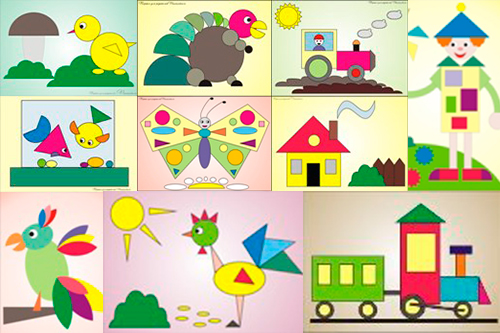
Crafts from geometric shapes are made using two main techniques:
- Decorating is the creation of patterns and ornaments from figures alternating in a certain order. Decorative crafts from geometric figures help to remember shapes, sizes and colors. They also develop creative and logical thinking, fantasy.
- Design — a more complex version of geometric applique, which consists of composing complex objects from simple shapes. Plane modeling teaches analytical thinking, the ability to mentally break complex objects into simple parts.
The simplicity of geometric shapes allows you to create sets of parts of different sizes. With their help, children study the transformation of shapes, develop cutting skills and spatial thinking.
How to choose an applique for a child
Crafts on a plane from geometric figures are a type of creativity that is accessible to young children. When choosing an applique, it is necessary to take into account the child's age and the development of his skills.
Toddlers can make simple crafts that consist of identically shaped parts. The youngest children can cover the figures with glue using a glue stick and arrange them in any order on the surface of the sheet.
The role of adults in this activity is as follows:
- in the preparation of paper parts;
- in demonstrating techniques for working with glue;
- in unobtrusive correction of the child's independent work.
Young preschool children know how to use glue and the names of basic geometric shapes. A 3-year-old child learns to analyze simple pictures, compare the sizes of elements in them and arrange the blanks in a certain order.
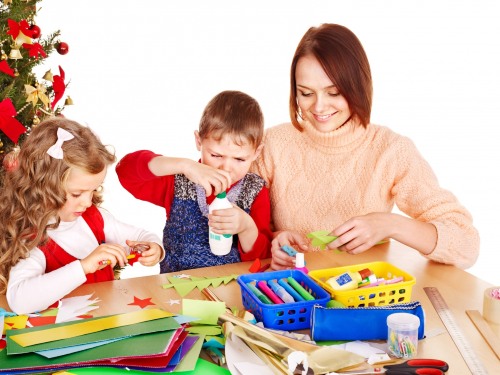
Crafts are made using two techniques:
- contour work involves placing details on a prepared drawing;
- pattern repetition is used to create patterns and ornaments;
- laying out a picture from several simple elements, in which the child first lays out the image, evaluates it, and then fixes the details.
Applications for children 4-5 years old are distinguished by a more diverse set of geometric shapes., which they cut out themselves using a template. The finished appliques are complemented with small painted details.
Senior preschool children use polygons and complex patterns in their creativity. They independently choose the colors of the figures and background, cut out the details. Complex crafts develop attention and perseverance, help prepare children for educational activities that require self-organization and concentration on achieving the goal.

The crafts of primary school students use plot compositions. When making complex appliques, children should pay special attention to the sequence of gluing the elements, their selection in accordance with the idea, and the color combination of the details.
By grades 3-4, students have sufficiently mastered the skills of creating complex plot applications and can create complex compositions. on a given topic. Children complete them independently, developing their imagination, creative thinking and focus on achieving the goal.
Tools and materials
Crafts from geometric shapes are created using a set of simple materials and tools, which are supplemented with new elements as the child grows up.
Paper
The main material for creating flat crafts is paper. It is used for the background and for cutting out geometric elements. For the base, you can choose colored cardboard or thick paper. Small details are cut out of double-sided medium-weight paper. Bright appliques are made from colored office sheets.
Glue
The adhesive composition is selected in accordance with the child’s age. For 2-year-olds, a paste made from potato starch or wheat flour is suitable for work. This glue does not cause allergies and will not cause harm if swallowed, so it can be spread on small parts with your fingers.
To make 1 liter of paste, 5 tablespoons of dry substance are diluted with a small amount of water until a homogeneous paste is formed. Then it is diluted with the remaining liquid. The solution is boiled over low heat until the mass is compacted and filtered through a sieve.
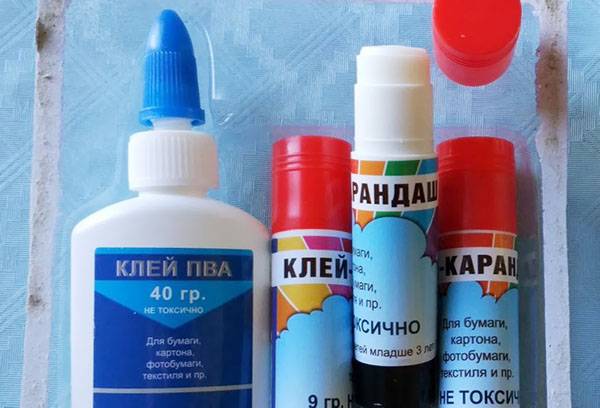
Children aged 3-4 years are comfortable working with stationery glue in the form of a pencil. When choosing it, special attention should be paid to the quality of the product. It should be applied in an even layer, not leave lumps on the paper and not have a strong smell.
PVA and brushes for its application are used by children from the senior group of the kindergarten. Working with liquid glue requires sufficient development of fine motor skills, attention and accuracy. Brushes for applying the adhesive substance to the paper are chosen of medium hardness. Their size depends on the size of the work piece.
Scissors
The main requirement for scissors used by children is safety. Scissors with round ends are bought for a child. Before starting a child's creativity, an adult should check the quality of the mechanism's functioning, since scissors with undeveloped levers can be dangerous for a child.
The blade length of children's scissors is approximately 10-12 cm. When cutting out larger pieces, longer models can be used.
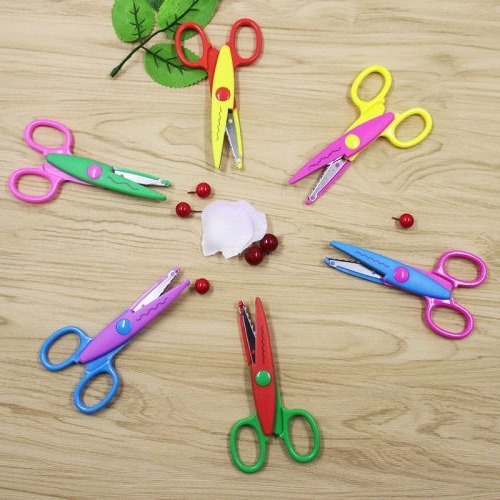
Important! Before teaching children to use scissors, it is necessary to introduce them to safety precautions, which include the following:
- You must not wave them or play with them while working.
- They should be passed forward in rings, holding them by the folded blades.
- After use, the tools are put away.
- Store scissors in boxes or high stands with the rings facing up.
Additional materials
The glue should be applied to the parts using a special backing. To do this, you can use a sheet of white paper or a thin plastic mat, which is cleaned with napkins as it gets dirty.
Beautiful small geometric details can be drawn using special stencils. You can buy them at a stationery store. You can make a geometric stencil yourself from a plastic folder, drawing figures of the required size on it. They are cut out using a stationery knife, placing a hard board under the work sheet.
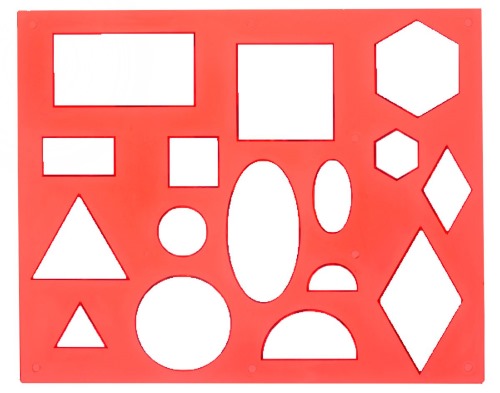
As additional materials, you can use fabric, ribbons, stickers, notepads, cotton wool and other items that will enrich and make children's creativity an interesting and exciting activity.
Organization of work
Crafts made from geometric shapes are a way to harmoniously develop children of different age groups.
When preparing an applique lesson, the following factors should be taken into account:
- age of children;
- level of development of thought processes;
- the degree to which a child has mastered the skills necessary to create an applique from geometric shapes.
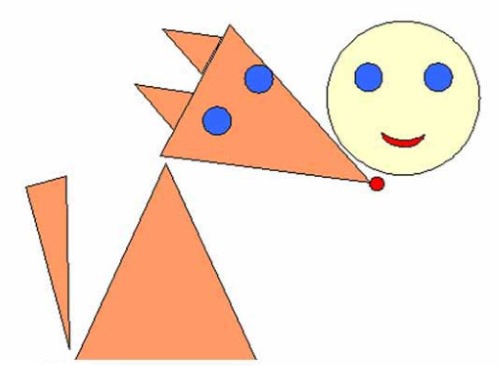
Each age group has its own specific features for organizing work on a craft:
- At the stage of familiarization with geometric applique, children learn a new activity based on already consolidated skills. Based on the game, children learn basic geometric elements, lay them out on a flat sheet of paper and glue them.
At this stage, an adult plays an important role, as he prepares the necessary set of figures and helps the child master the correct technique of using glue.
During individual lessons with a 3-4 year old child, educators begin to develop the skill of working with scissors (cutting out simple figures: rectangle, square, triangle). After completing the creative process, children of younger preschool age can help clean up the workplace.
- At the age of 4-5 years, children begin to participate in preparing figures for applique, independently working with scissors. In doing so, they repeat their actions after the parent or teacher, who prepares a sample picture and then repeats it together with the child.
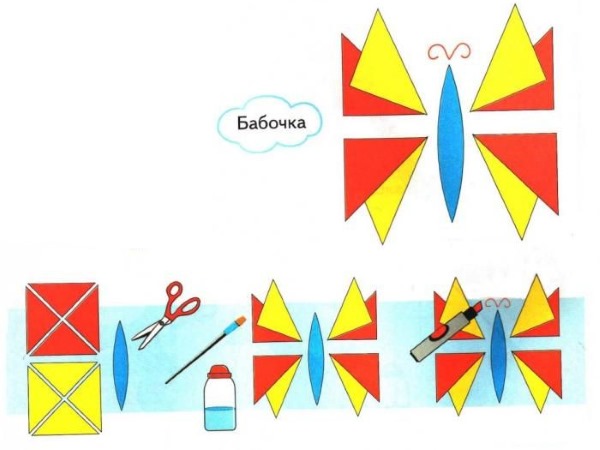
At the end of the work, the child independently evaluates the correctness and neatness of his craft. Important! Children's creativity should not be criticized by an adult. He should gently point out the shortcomings and advise how to avoid them in the future.
- By the age of 5-6, children have sufficiently mastered the skills of working with scissors. and can independently (using a ready-made outline or template) cut out geometric details. Older preschoolers independently choose color combinations for a particular craft.
An important innovation in the organization of creative activity is the absence of a model. The child, with the help of an adult, analyzes the object, breaking it down into simple forms, and selects the appropriate figures for work.
- The creation of geometric appliques in primary school children is aimed at developing creative thinking, analytical skills and imagination. Therefore, an adult assistant only suggests a topic for work and several examples of its implementation, giving the child the opportunity to independently choose the necessary materials and forms for its implementation.
In all age groups, proper organization of the workspace plays an important role.
For the convenience of children, the following scheme should be used:
- In the center of the work surface are placed ready-made forms or sheets of colored paper.
- There is a background in front of the child.
- On the left is a mat for working with glue, and on the right are napkins for hands and pressing parts to the base.
- Glue brushes and scissors are placed in a special stand in the upper right corner of the table.
- Place the liquid glue in a shallow container on a tray in the center of the work surface.
Important! Proper preparation and organization of work on the applique will make this activity an exciting game, and a development of creative abilities, and a means of learning about the world around us.
Applique ideas for the little ones
Children aged 1-2 years are just beginning to get acquainted with geometric figures and applique. For little ones, the process of gluing paper parts to the base is of great importance, so their crafts do not have a clear composition. All classes with young children are held in a playful manner, individually or in small groups.
Balls for the bear
Creative activity is carried out in the form of a game-task. It is preceded by a story about a juggler bear who lost his balls.
Objectives of the lesson:
- introduce the child to the shape of a circle and the concept of size;
- consolidate knowledge about colors;
- develop skills in working with glue.

Instruments and materials:
- circles of 3 sizes made of double-sided colored paper;
- a ready-made bear figurine (you can use a bright sticker);
- A4 sheet of colored cardboard;
- glue from starch (flour);
- wet and dry wipes.
Progress of the lesson:
- An adult begins to tell a story about a cheerful bear who loved to throw balls into the air. After the first part of the tale is finished, a figure of a bear is glued to the base sheet. With the help of an adult assistant, the sticker is carefully peeled off the base and placed in any place on the background surface.
- "The bear got distracted and all the balls rolled away. He got upset and went to look for them." The child is asked to help find balls of a certain size or color.
- The child independently covers one side of the piece with glue using his finger, applying it from the center to the edges.
- With both hands he takes it by the edges, turns it over and places it in any place on the base.
- Using a dry cloth, the detail is pressed against the background.
- After finishing work, children are given colored plastic balls to play with.
Plate with berries
For children at the end of their second year of life, you can offer a more complex craft that will reinforce their knowledge of basic geometric shapes and colors.
 Materials and tools:
Materials and tools:
- large white circle (plate);
- a set of multi-colored circles and triangles of various sizes;
- a set of pictures depicting berries and fruits;
- paste or glue stick;
- rug;
- napkins.
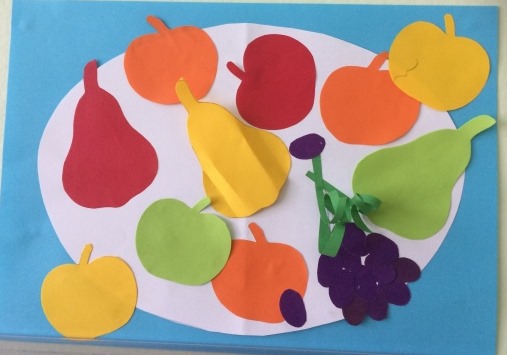
Progress of work:
- Children name the fruits and berries shown in the pictures. They are compared with geometric figures.
- The selected elements are arranged in random order on a circular base.
- After completing the activity, the child, with the help of an adult, repeats the names of berries, flowers and shapes.
Applications for children 3 years old
At 3 years old, children can arrange figures in a certain order, creating images of simple objects. They consist of 5-6 figures, located on a background that is appropriate in meaning.
Hen and chicks
The craft made from geometric shapes depicts representatives of the animal world that are well known to the child.
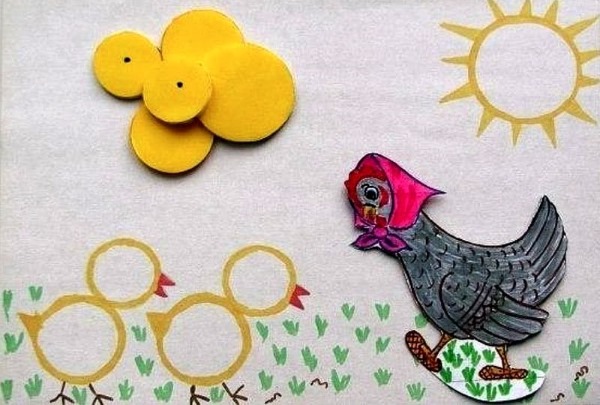
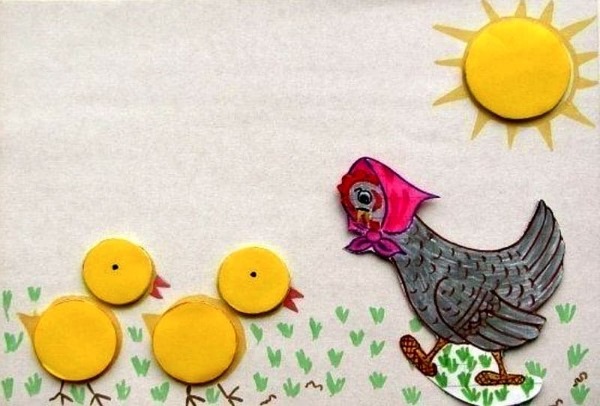
To make an applique of a chicken with chicks, you will need the following materials:
- a sheet of green cardboard;
- 3 yellow circles;
- 2 white circles of different sizes;
- triangles (6 orange, 2 yellow, 3 red, 1 white);
- felt-tip pens;
- glue stick.
Progress of work:
- An adult prepares a sample of the craft.
- Focusing on the adult work, children lay out the prepared elements on the background. At this stage of the work, you should focus on the individual characteristics of the child. For some children, it is convenient to lay out the entire picture, and for other kids it is easier to stick one figure at a time.
- The finished figures made from geometric elements are complemented with dotted eyes applied with a black felt-tip pen.
- If desired, the craft can be supplemented with additional elements (a round sun, rectangular strips of grass, small triangles of flowers).
- At the end of the work, each craft is discussed individually. The teacher or parent tactfully points out mistakes and notes positive features.
New Year tree
A 3-year-old child can make a beautiful New Year greeting card.
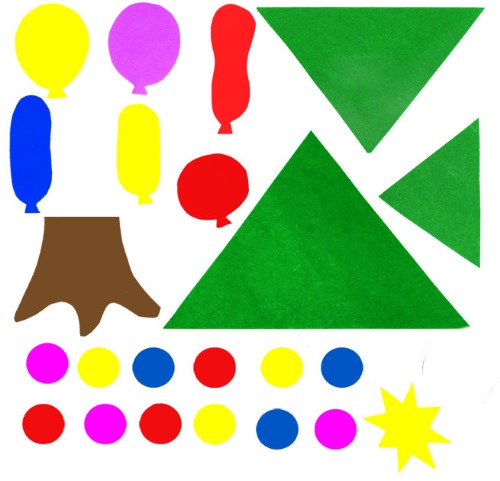
To create it, you need to prepare:
- a sheet of white paper;
- 3 green triangles;
- small circles, triangles and rectangles;
- gel based glitter;
- glue stick.
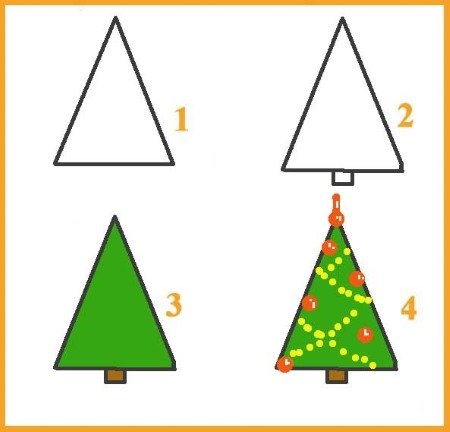
Progress of work:
- An adult prepares several pictures depicting a New Year tree.
- The children and the teacher simultaneously fold a large sheet of paper in half, forming the basis for the postcard.
- In the center of the workpiece, large green triangles are located one above the other. It is necessary to clarify that the tops of the parts are located on one vertical line.
- 2-3 lines of flags are formed from small triangles and rectangles. The child determines the color, quantity and arrangement of the elements independently.
- Round multi-colored balls are placed randomly between the flags.
- The edges of the card are decorated with patterns using gel glitter.
Applications of geometric shapes for children 4-5 years old
A child of 4-5 years old has sufficient skills to create a craft from geometric figures cut out independently. The number of simple elements in the applique increases to 15-20 pieces.
House in the forest
To make a plot applique you will need the following materials and tools:
- a sheet of white paper for the base;
- multi-colored scraps of colored paper;
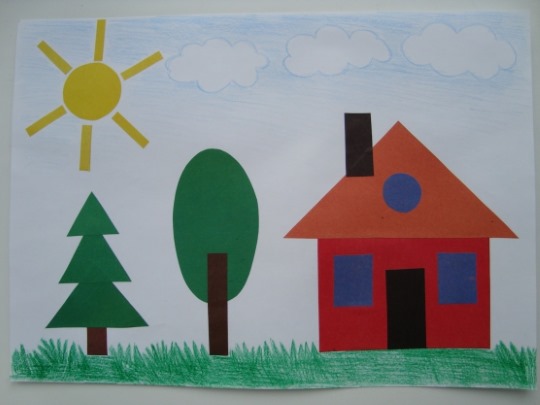
- scissors;
- glue stick or PVA;
- dry wipes.
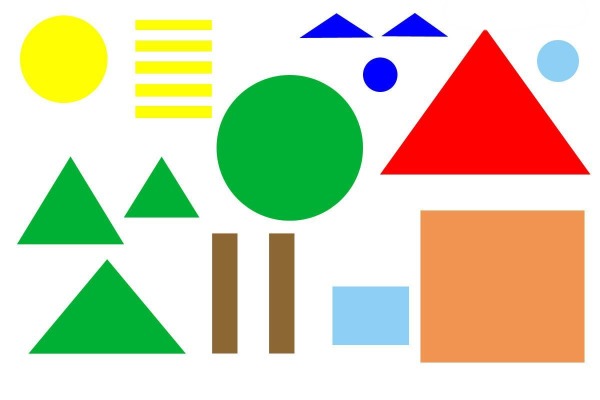
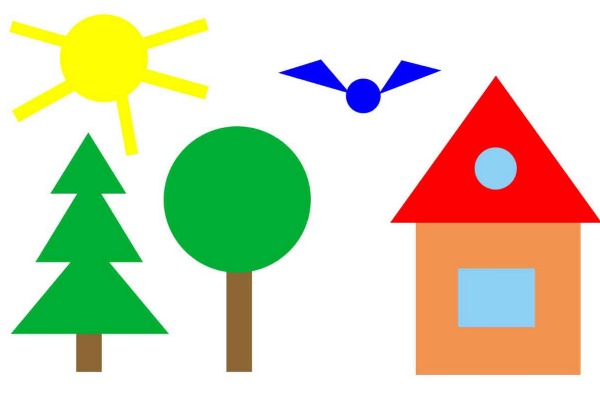
Progress of work:
- The teacher and the child determine the main elements of the applique and the figures they consist of.
- Children cut out the necessary figures themselves from scraps of colored paper.
- Geometric elements are distributed on the background sheet, forming a unique composition.
- The figures are glued to the base, starting with the larger pieces.
- At the end of the work, a joint analysis of the result is carried out.
Merry little train
At senior preschool age, children can create multi-figure appliques, complementing them with additional elements.
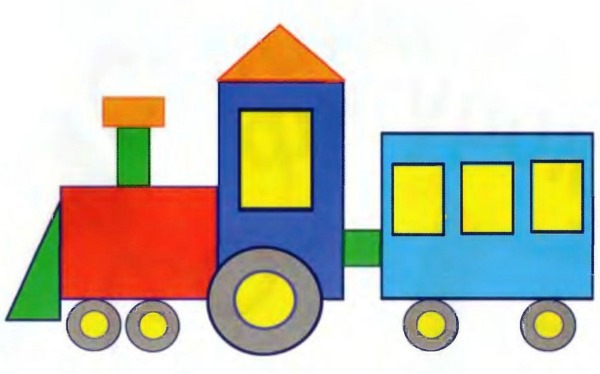
Materials and tools:
- 3 colored rectangles of the same size;
- 1 smaller rectangle;
- triangle;
- 6 small circles, the colors of which correspond to the colors of the large rectangles;
- 5 white squares;
- 1 large yellow circle;
- 2 white ovals;
- green cardboard for the background;
- glue;
- felt-tip pens;
- ruler;
- simple pencil.
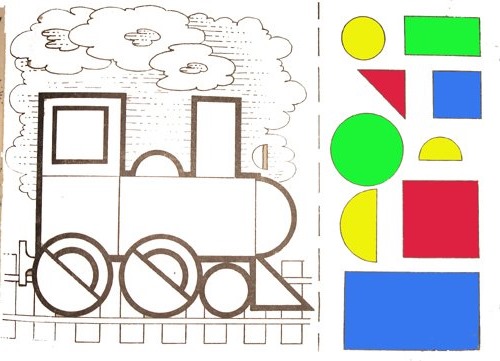
Progress of work:
- The background sheet is placed horizontally in front of the child.
- Using a ruler and a simple pencil, draw a line at a distance of 5 cm from the bottom edge.
- Large rectangles (cars) are glued to this line.
- A small rectangle (cabin) is glued to the top edge of one of the side pieces.
- Then the composition is supplemented with small details (wheels, windows, pipes).
- Animals are drawn in the windows. The drawings can be replaced with colored stickers.
- A round yellow sun and clouds are glued to the top of the sheet.
Applications for children of the senior group of kindergarten
Children aged 6-7 have good skills in working with glue and scissors, know the names of simple and complex geometric shapes, and can therefore independently create complex appliques from a variety of shapes.
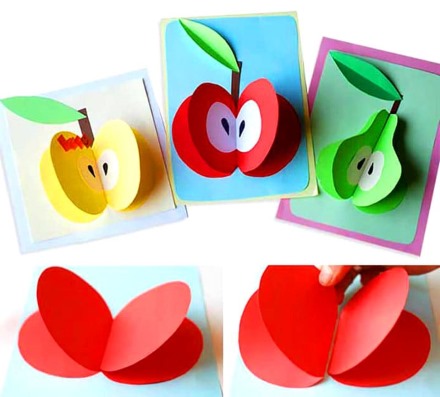
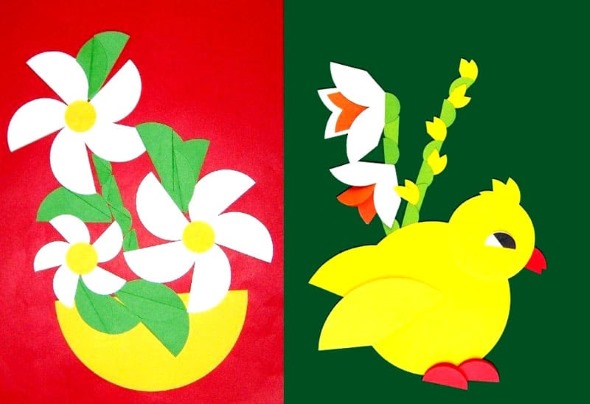
The following crafts are made using the applique technique:
- Representatives of the animal world (fox, bear, elephant, owl, ladybug).
- Transport (car, ship, plane, rocket).
- Plants (flowers, trees, grass).
For students of grades 1-2
In the lower grades of primary school, applique classes are designed to develop creative thinking, perseverance and observation skills.


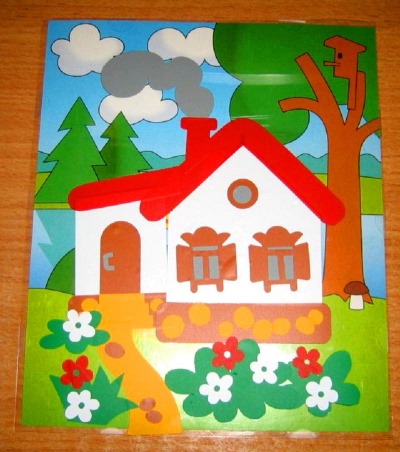


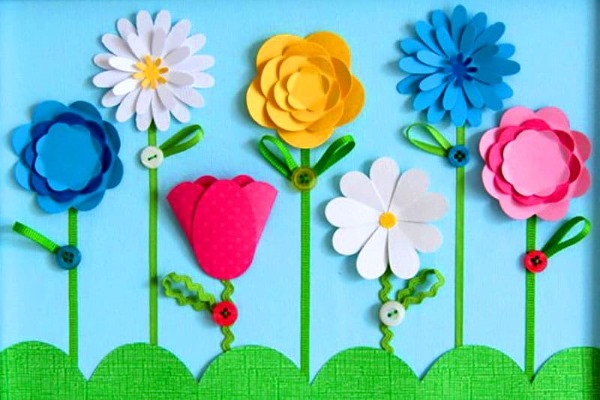
Crafts can be made using the following techniques:
- Ornament is the decoration of silhouettes of objects or animals with small geometric details. As a basis for decoration, you can choose dishes, a butterfly, a dragonfly.
- Mosaic - filling the outline with small squares (plants, animals, simple landscapes).
- Flat design of complex objects (cars, houses, plants).
For students in grades 3-4
Children aged 9-10 can independently create applications on a given topic, for example:
- In the craft “Sea” you can depict a ship and sea animals.
- The applique on the theme “Winter” is created using a mixed technique of flat construction and mosaic.
- “Summer in the village” can depict a house with a fence, trees with fruit, animals.
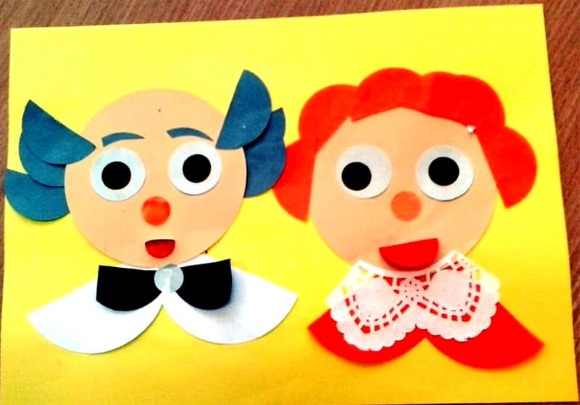

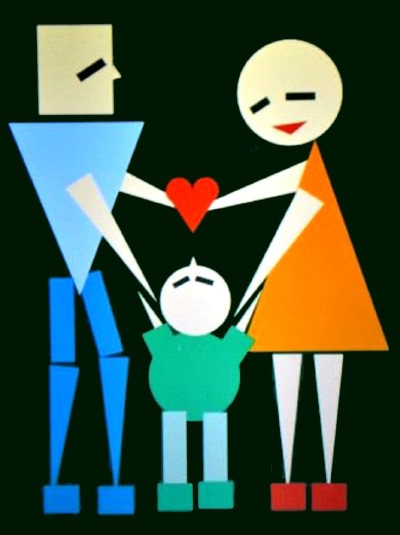
Crafts in which objects are made from geometric figures help develop the child's creative abilities. At the same time, they become familiar with figures and colors, and also master the skills of using a brush and scissors.
Article formatting:Natalie Podolskaya
Video about crafts from geometric shapes
Applications, crafts from geometric shapes for children:
https://www.youtube.com/watch?v=Wc0iWRbjGQE
